Heuristic play: How toddlers learn through discovery
Babies ask: what is this like? Toddlers ask: what does this do? This subtle shift opens up the world to exploration.
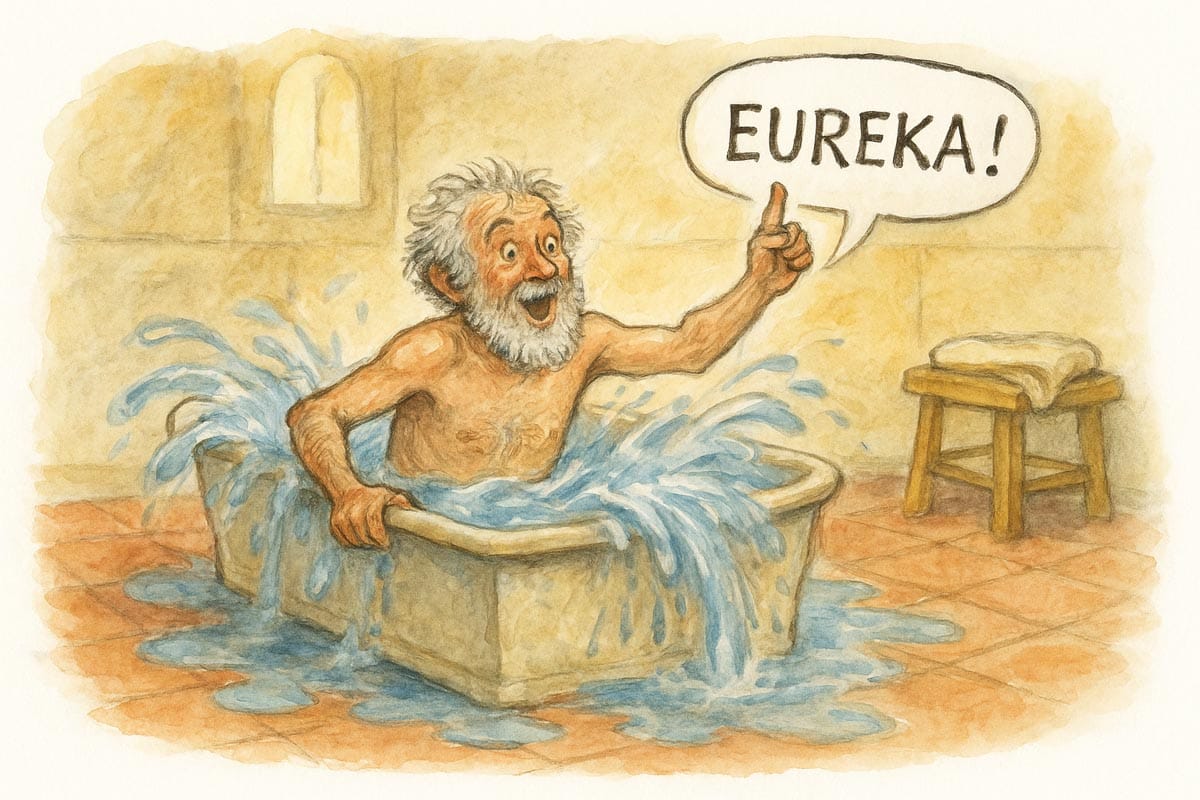
This crown is a fake! It's not made of real gold! But how can I prove it?
Send for Archimedes!
The Greek mathematician and philosopher sank lower into his bath and pondered the king's question.
And as he did so, he noticed the water level rise.
Eureka! he cried. And leapt out.
And, depending on which version of the story you believe, he ran naked down the street to proclaim his discovery to the world.
Two thousand years later, 'eureka', the Greek word for 'I found it!' has given us 'heuristic', meaning an efficient problem-solving strategy.
What is heuristic play?
Heuristic play is:
- Play with real, everyday objects
- Using problem-solving and trial and error
- By toddlers
- Without adult supervision
- To find out how things work
So heuristic play is discovery play. It's the play of finding out.
Archimedes had a question. He answered it by testing and noticing – just like your toddler.
1. Babies: What is it like? Sensory exploration through mouthing and banging
2. Toddlers: What does it do? Heuristic play - endless posting, filling, emptying
3. Preschoolers: What can it become? Symbolic play - objects transform into anything
Trust the process. The mess is the method.
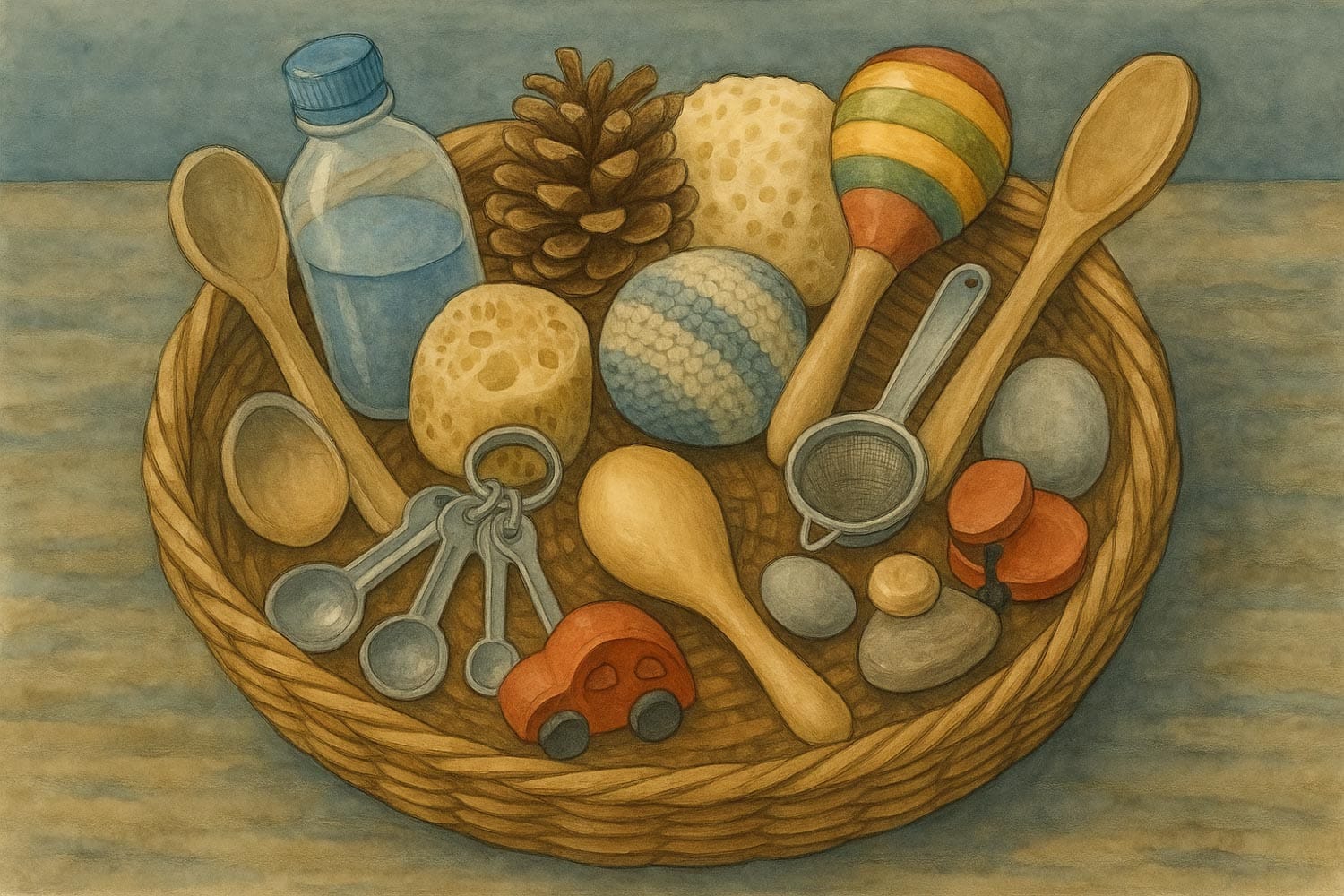
Treasure baskets: "What is it like?"
Before your child can work out what things do, she must first be familiar with the materials that make them up.
From 6 - 12 months, a treasure basket is the perfect introduction to this kind of sensory play. Gather a range of child-safe materials, offering a range of tastes, textures and smells and leave your baby to explore. She will mouth and grasp, bash and drop, shake, poke and roll. She is in search of new experiences so keep it fun and fresh. Familiar materials are soon forgotten.
By the time the toddler years come around, she will know all there is to know about the taste of metal and wood and fabric. Her hands will be strong and dextrous, her limbs under full control.
She is ready for deeper learning. It's time for heuristic play.
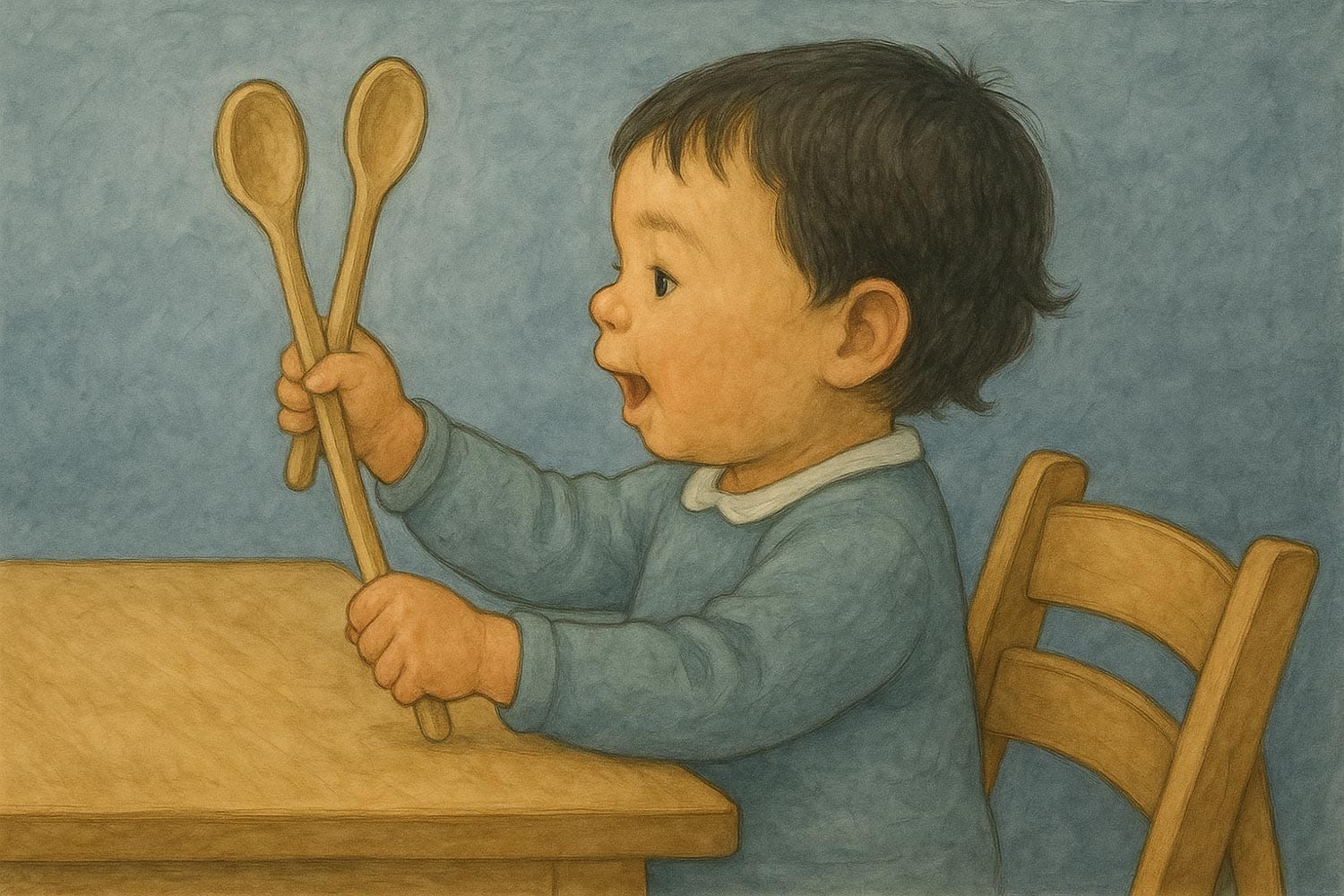
At home with Sophia
Sophia discovers the wooden spoons this morning.
Not the plastic ones from her toy kitchen, but the real ones from the drawer. Her mother has left them on the kitchen table while she bakes, and Sophia is captivated.
She picks up the first spoon, examines it carefully, then bangs it on the table. The sound is satisfying - deeper and richer than her plastic toys. She tries the second spoon. Different wood, slightly different tone.
Now she holds both spoons and brings them together. Clack. She repeats the action, listening intently.
Her mother watches, resisting every instinct to suggest "better" ways to use the spoons.
Here's the trick with heuristic play: your role is to work out where your child is going with her investigations. What's the logical next step? What will grab her attention?
Without interrupting the play, place a metal spoon next to the wooden ones and walk away. Did that work? Did it extend the fun? If so, what next? A second metal spoon or a plastic one? Or a different utensil entirely? Balloon whisks make a soft, sleigh-bell jingle. If she was exploring sound, it could be the perfect addition.
But what if her interest was in striking. In that case, you should offer something to hit: a clanging steel pan, a crackling yoghurt pot or a box of Rice Crispies that hisses like a snare drum.
In later years, crayon in hand, the downward swing of the hammering arm becomes the descender of tall letters like 'd' and 'h'.
It's a long journey, and each child takes a different route, but heuristic play makes sure we cover the bases in a fun and pressure-free way, one skill at a time.
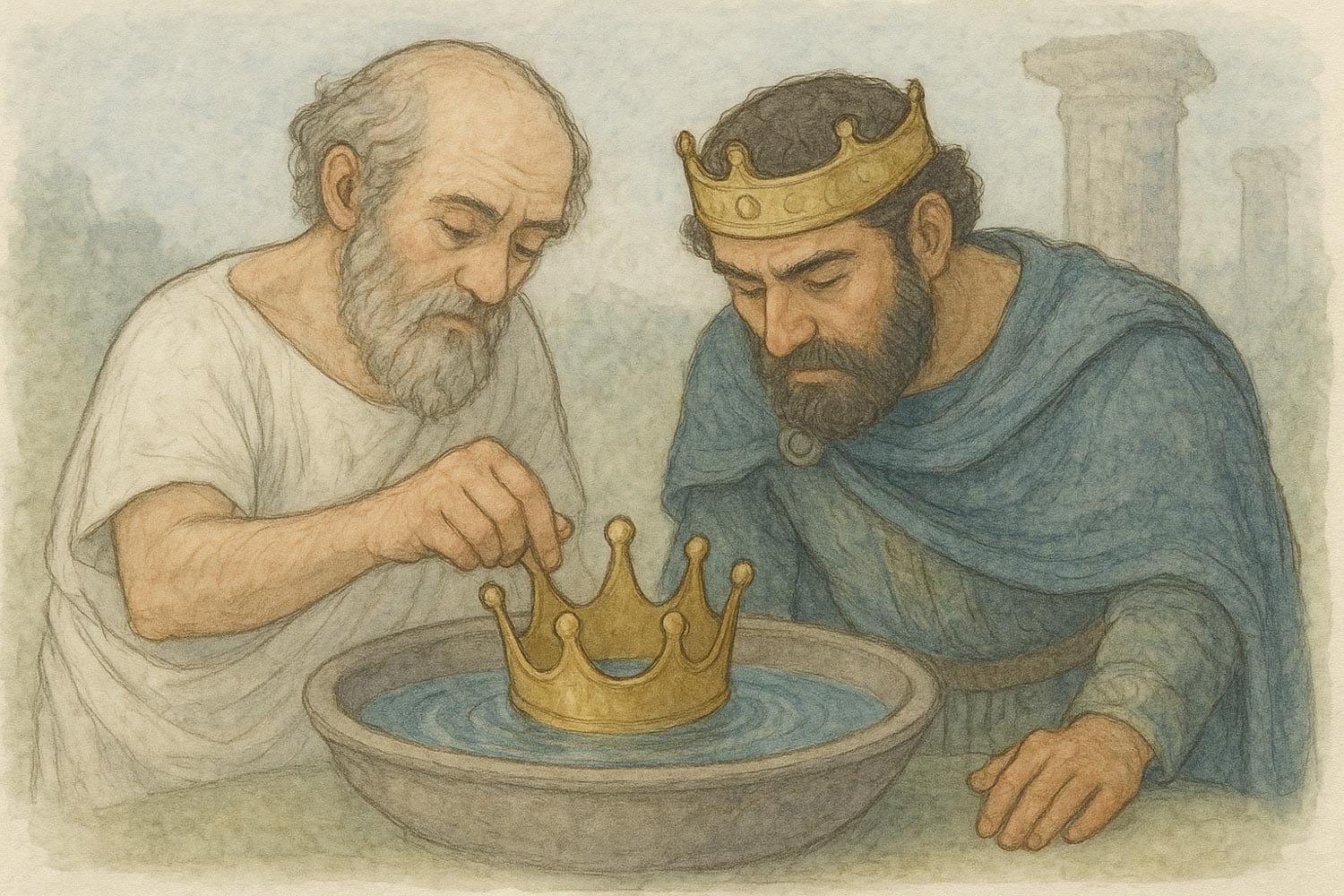
Developmental psychologist Jean Piaget demonstrated that abstract thinking emerges from physical manipulation of objects. Children who engage extensively in hands-on investigation develop stronger mathematical and scientific reasoning abilities than those who learn through verbal instruction alone.
You are a play curator
The most powerful heuristic materials aren't toys - they're real objects that offer genuine feedback. But the magic lies not in the objects themselves, but in how you select and present them.
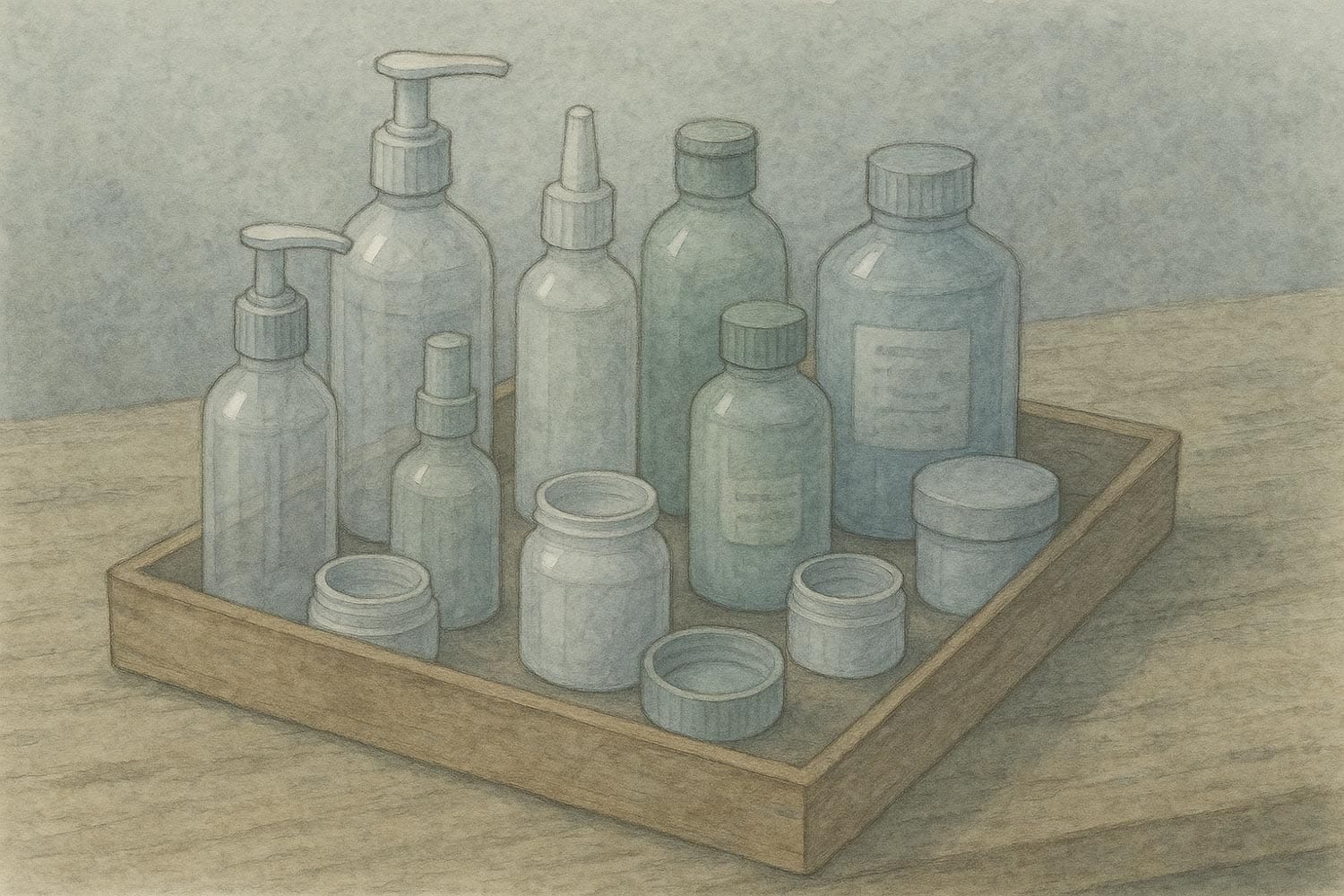
When you put a collection of objects on a tray, your child asks herself: what do these things have in common?
You can 'teach' the idea of twisting and untwisting simply by presenting a tray of bottles with tops and jars with lids. In subtly different ways, they can all be opened with an anti-clockwise rotation.
And, again, years down the line, that anti-clockwise turn becomes the basis of a whole family of letters: c, o, d, a and g.
But don't worry to much about the end game. We're here to have fun.
Offer a variety of interesting experiences and you'll do just fine.
Let's take a look at the kinds of heuristic play that you can get started with today.
Curation by properties
Single property collections invite deep investigation of one concept. Present materials that vary in everything except one shared characteristic:
Texture focus: Smooth river stones, polished wooden blocks, silk fabric, metal spoons - all different materials unified by their smoothness. Or rough bark, sandpaper, pumice stone, coarse fabric - exploring roughness across contexts.
Weight: Heavy materials of different sizes - metal containers, stones, wooden blocks, thick books. Light materials that surprise - large foam blocks, empty cardboard boxes, fabric pieces, paper tubes.
Playing with light: Coloured acetate, a magnifying glass, a cardboard tube, a prism, a tailor's loupe, a translucent coloured bottle, window blocks and mirror blocks, a small torch.
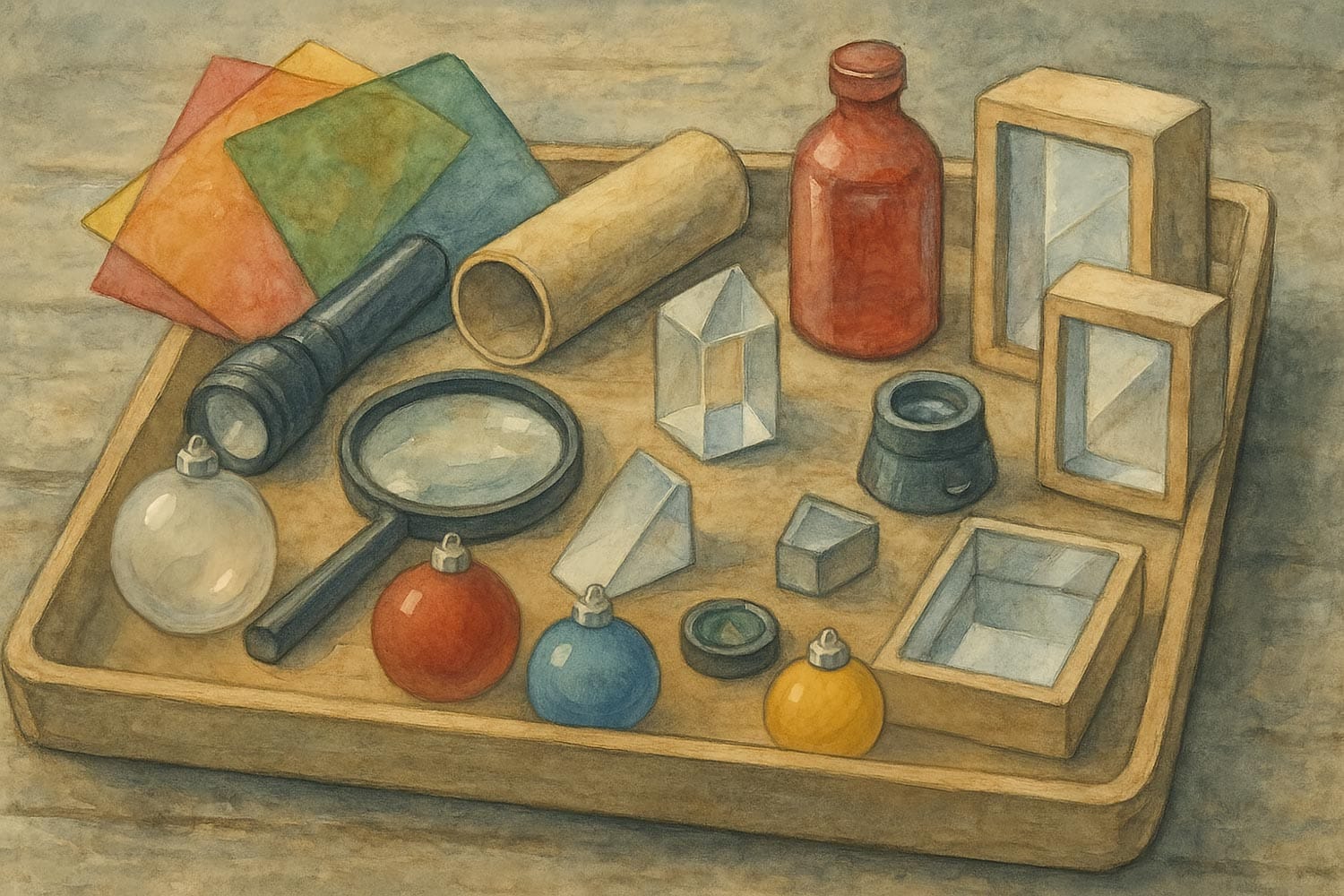
Sound: Materials that create noise when manipulated - metal containers, wooden blocks, ceramic bowls, keys, bottle caps. Silent materials for contrast, like fabric and foam.
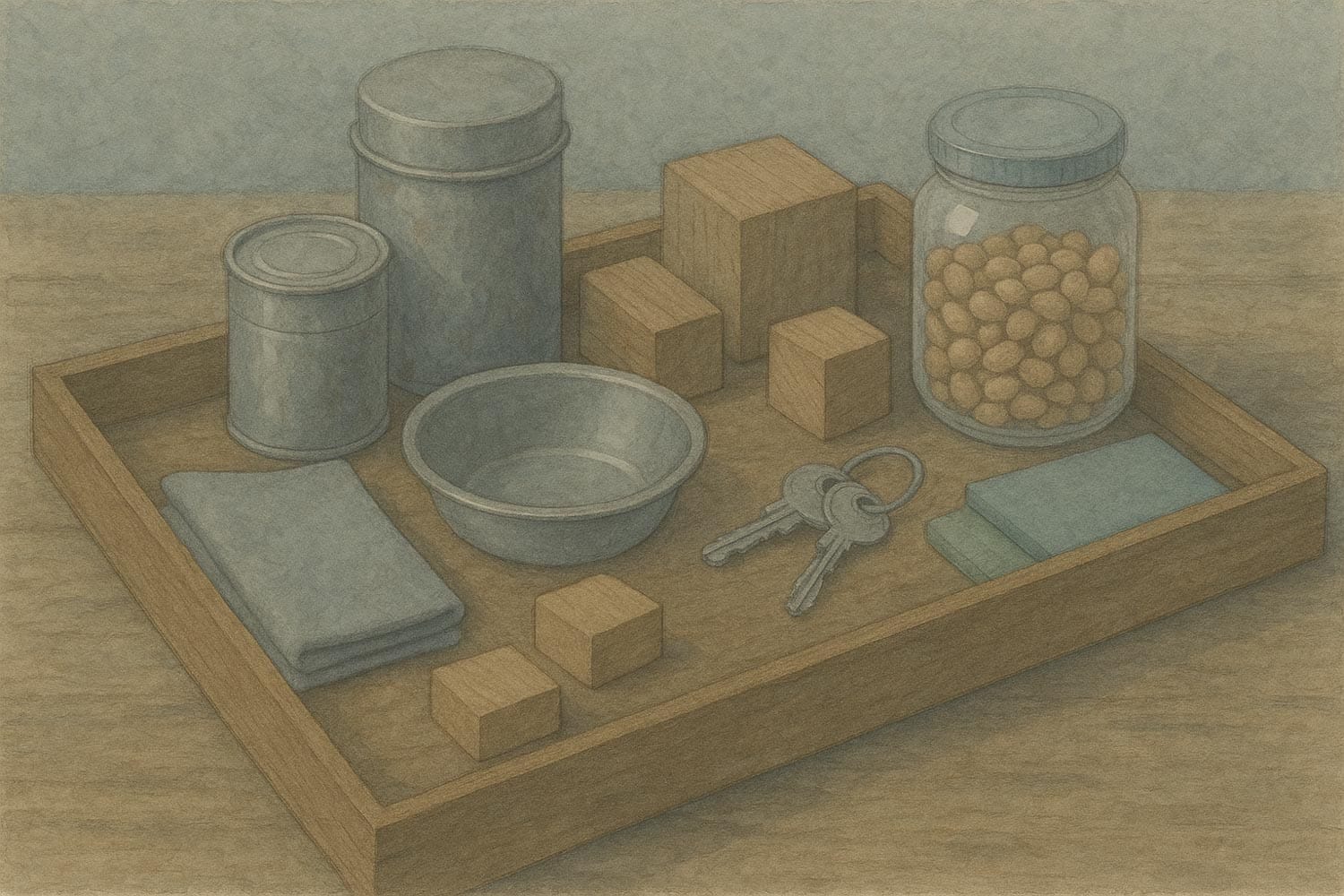
Curation by function
Opening and closing: Jam jars with screw lids, Tupperware with snap lids, pill containers with safety caps, matchboxes, hinged tins, fabric pouches with drawstrings, bottles with cork stoppers.
Nesting: Russian dolls, measuring cups, mixing bowls, cardboard boxes of graduated sizes, fabric bags, plastic containers that fit inside each other. These are didactic materials. They teach. Assemble Russian dolls in the wrong order and the mistake is obvious - the figures won't nest.
Posting: Colander with varied hole sizes, cardboard box with cut openings, paper towel tubes, wide-mouth jars, mesh orange bags, old tennis ball container.
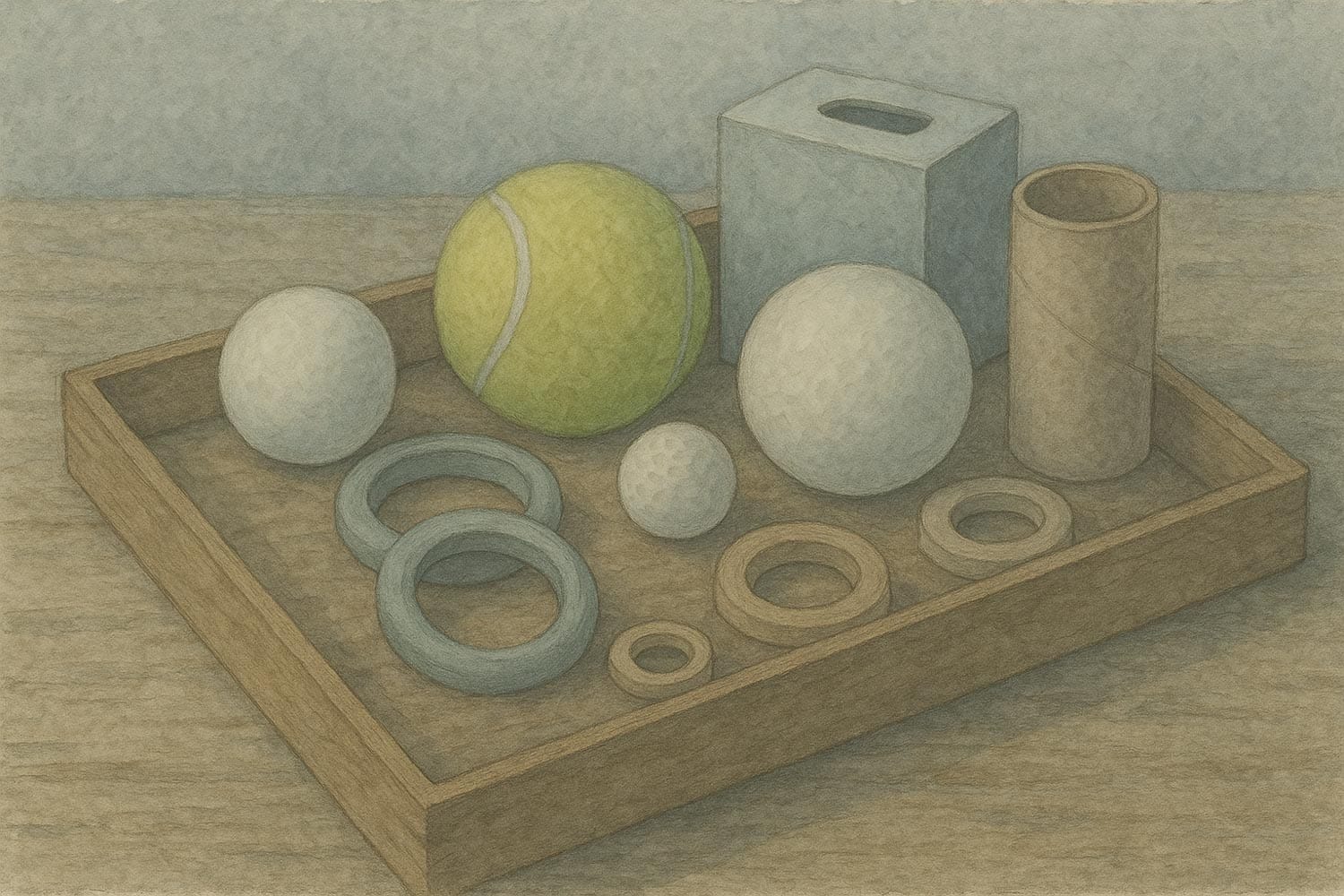
Stacking challenges: Wooden blocks, empty tins, cardboard boxes, wooden wheels, large buttons, ceramic bowls of different sizes.
Curation by material type
Natural treasures: Pine cones, shells, smooth stones, interesting sticks, large seed pods, coconut shells, pieces of bark, dried gourds.
Household objects: Wooden spoons, measuring cups, whisks, colanders, metal bowls, ceramic containers, fabric napkins, cork trivets.
Craft materials: Large buttons, ribbons (kept short for safety), wool balls, fabric scraps, interesting papers, empty cotton reels, curtain rings.
Things that move: Old keys, door handles, hinges, springs (large enough to be safe), wheels from broken toys, gear mechanisms.
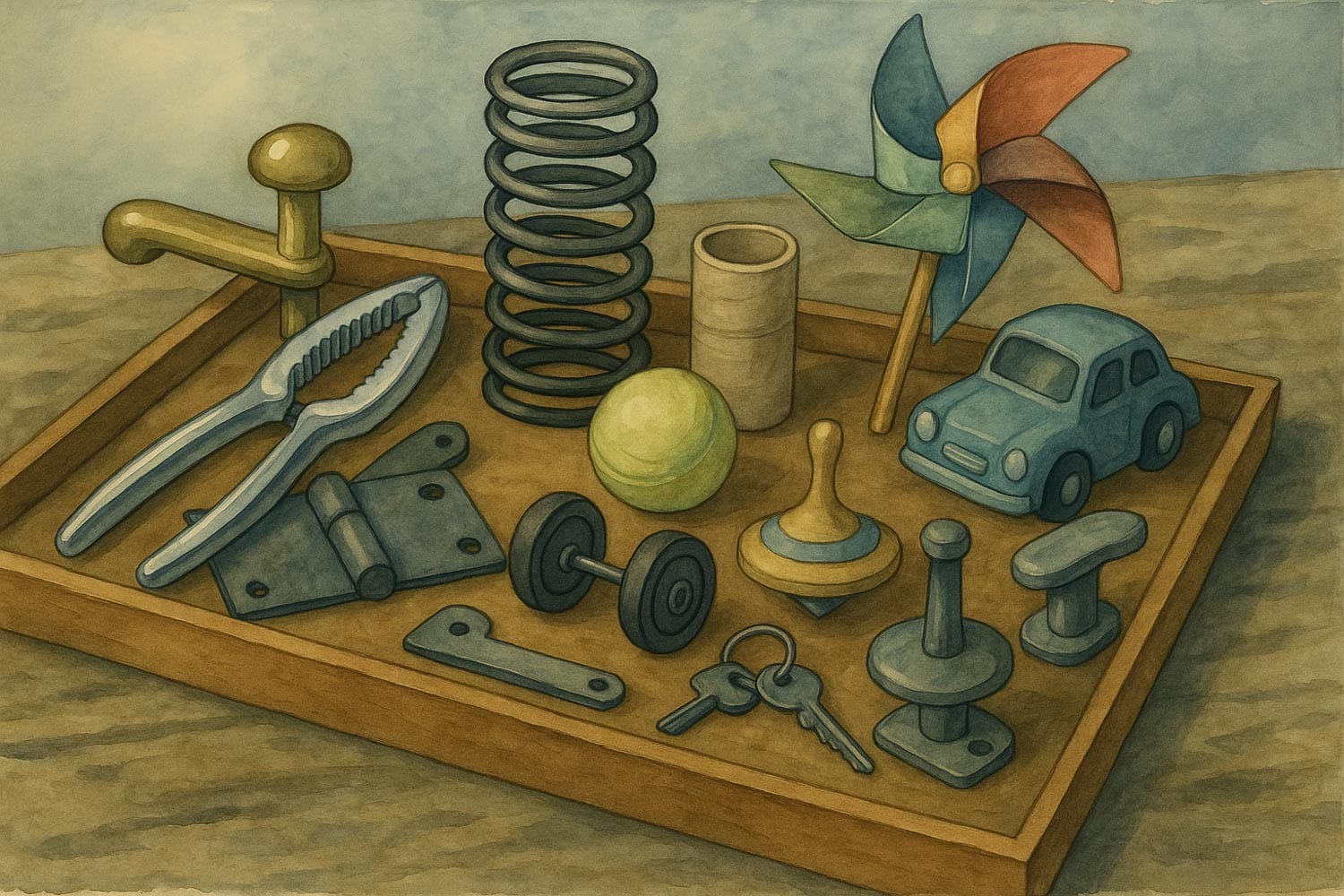
How to present your heuristic materials
Treasure basket: Fill a natural wicker basket with 10-15 carefully chosen objects. Make it feel more grown up by placing it on a low table rather than the rug. Change the collection weekly, keeping some familiar items for confidence while introducing new materials for investigation.
Concept containers: Group materials by investigation potential in trays or boxes. Depending on your child's age and temperament, you might feel brave enough to keep them accessible, Montessori-style, on open shelves.
Daily discovery tray: Putting a mini discovery tray on the table or high-chair tray keeps your child seated and busy while you get the breakfast ready - always a challenge in the Play with Purpose house!
Seasonal rotations: Include materials that connect to current experiences - autumn leaves and acorns, spring flowers and new growth, holiday textures and objects. This adds rich sensory variety and connects indoor investigation to outdoor observation, but be sure to check materials for safety and suitability.
Angeline Lillard's studies of Montessori education show that children who spend extensive time with concrete manipulative materials in early years outperform peers on standardised tests of executive function and mathematical reasoning. The hands-on foundation proves crucial for abstract concept development.
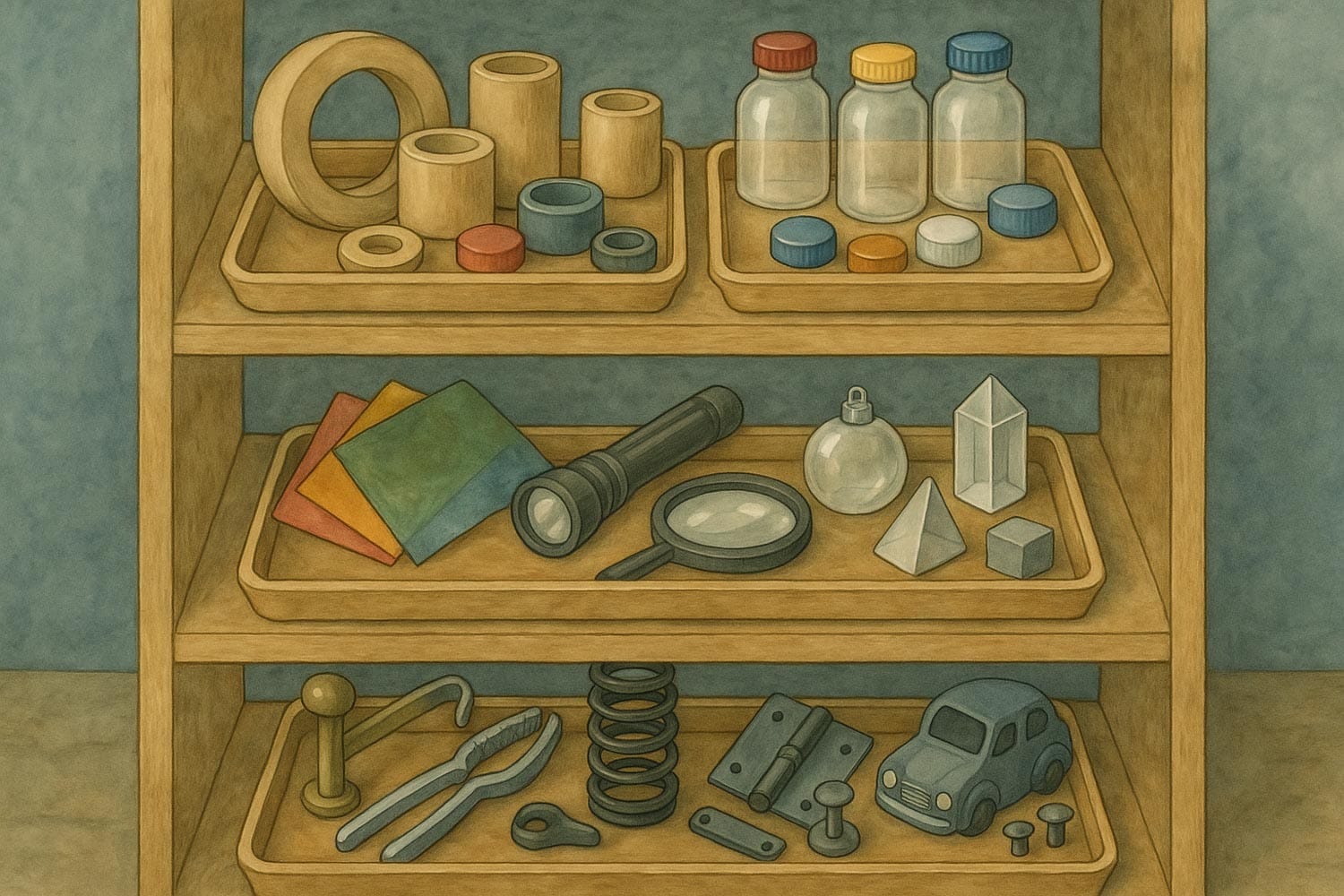
Building sustainable habits
As a preschool teacher, I had the space to create and store ready-to-go trays full of carefully-curated materials. Gears, wheels, bottles and lids; clips, bags, loose parts and bowls.
But as a parent, I have to pull things out as I go. Fortunately, between the kitchen and the recycling box, I have everything I need.
Which is just as well because I seem to spend 90% of my waking hours either making meals or clearing up after them.
My youngest daughter loved to mix. Flour, water, oil, paint - anything she could get her hands on. So as I cooked meals, I'd leave a few ingredients on the table alongside a bowl and mixing spoon.
Up! Daddy up!
Arms stretched towards me, she begged to be lifted into the highchair.
And so the 'scheduled' heuristic play began. I cooked while she explored.
Sometimes at the table, sometimes on the floor (a small builder's tray is great for containing mess), but always on offer.
Such an easy habit to embed. No trouble at all. She played independently, with no input from me. I was nearby and that was enough.
I'd look over from time to time, introducing new materials if the challenge was getting stale or subtly rearranging things to provide a nudge if she had reached a dead end.
Where heuristic play leads
Heuristic play doesn't last forever. Before her third birthday, your child will take the wooden that she loved to bang and declare it to be a magic wand - or the key to a treasure chest. "What does this do?" is now "What can this become?"
This marks the transition from functional to symbolic play. One thing stands in for another.
But the learning from heuristic play doesn't disappear. It becomes integrated into larger structures. Pouring water from two smaller jugs into one larger one - and then back again teaches the idea of reversibility. When your child gets to school, the relationship between 4 + 6 = 10 and 10 - 6 = 4 will be much easier to grasp.
And all without a worksheet in sight.
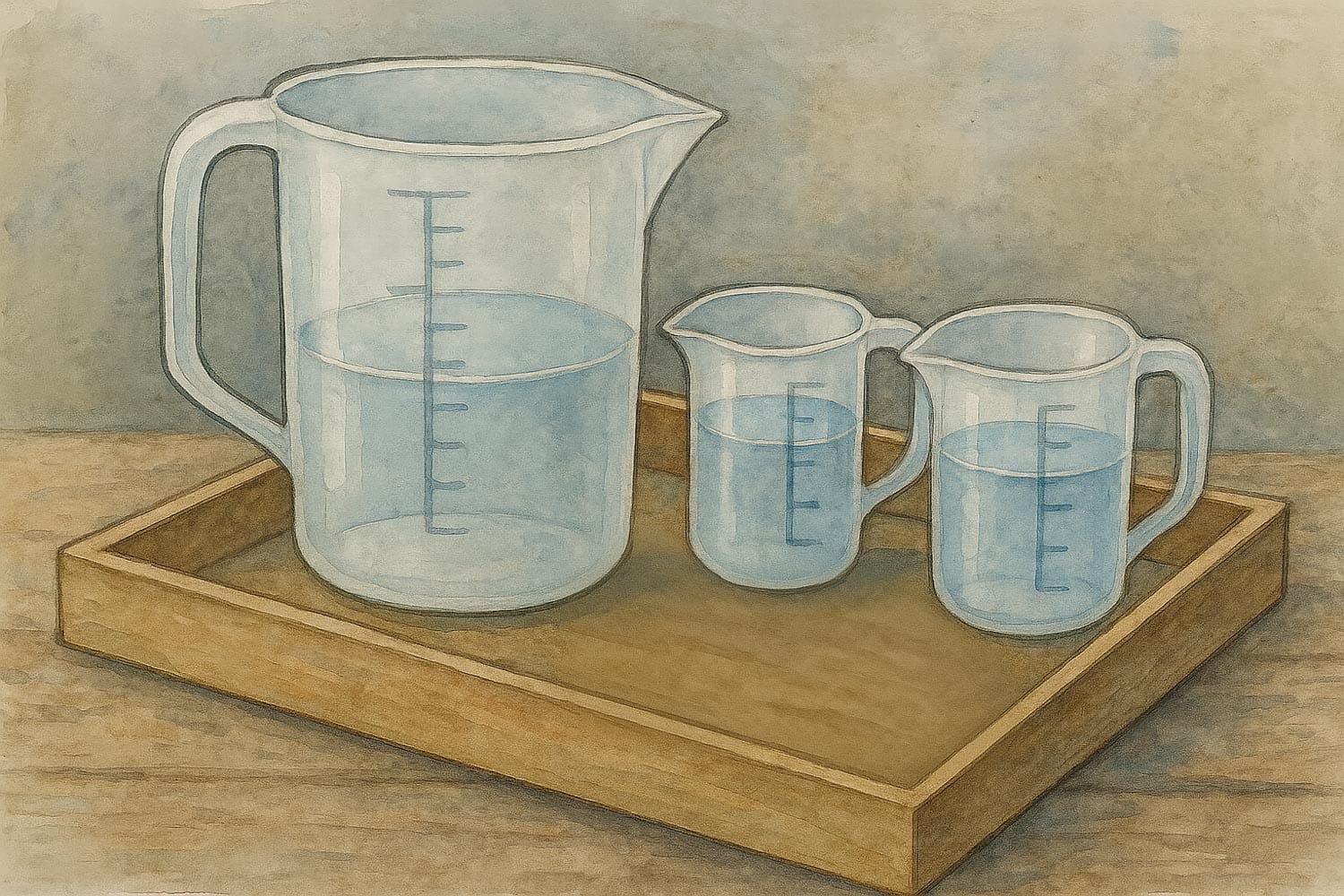
This is heuristic play at its finest: systematic investigation driven by natural curiosity, supported by thoughtful environmental design, and protected by adults who understand that the most important learning happens when children are free to follow their own questions into genuine discovery.
Final word
Heuristic play is real play, natural play. Play that fits into everyday life. You don't need dedicated time or special materials, just a willingness to say, 'yes'.
Your kitchen is a lab; your child is the scientist.
Give her the freedom to investigate.
Comments ()